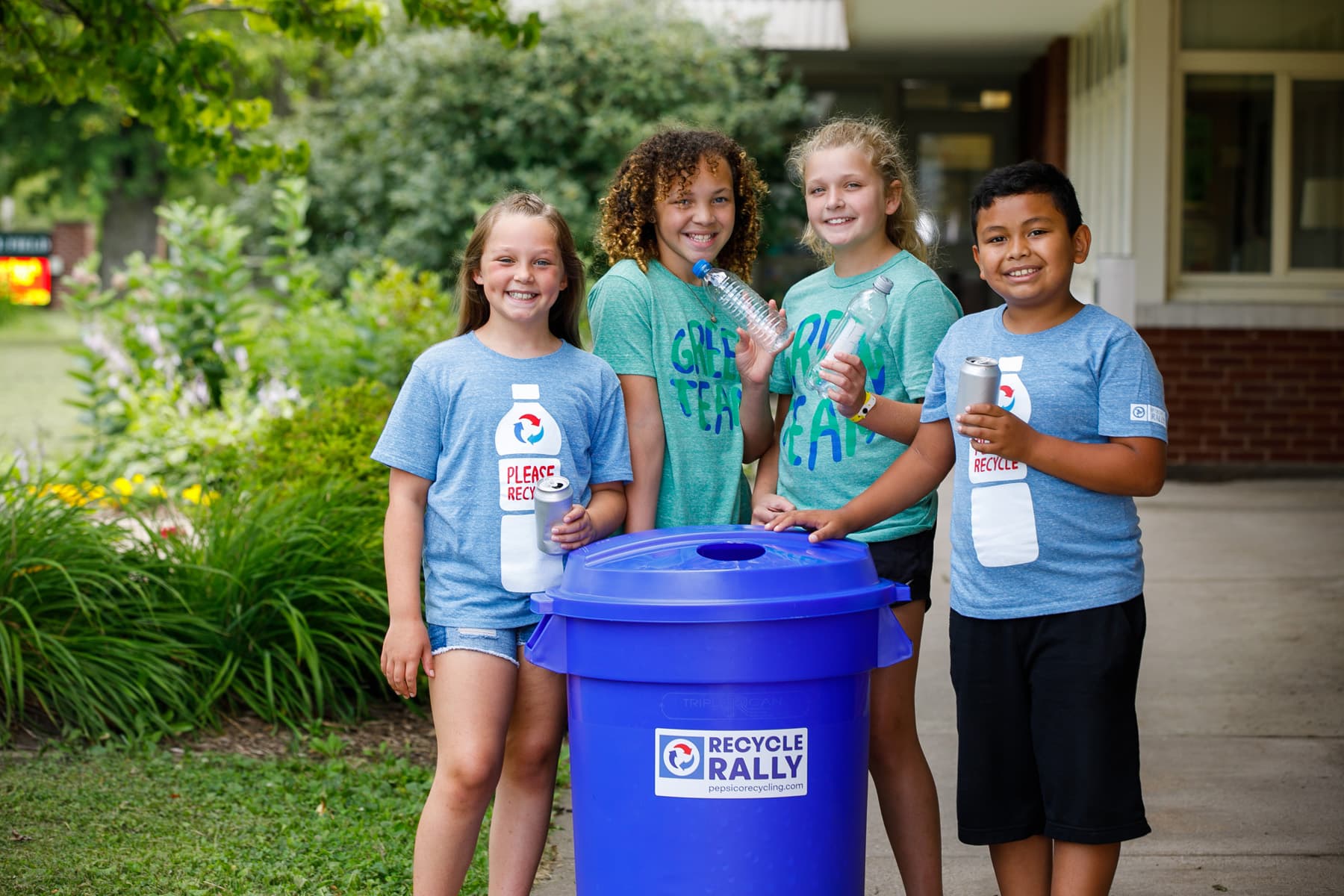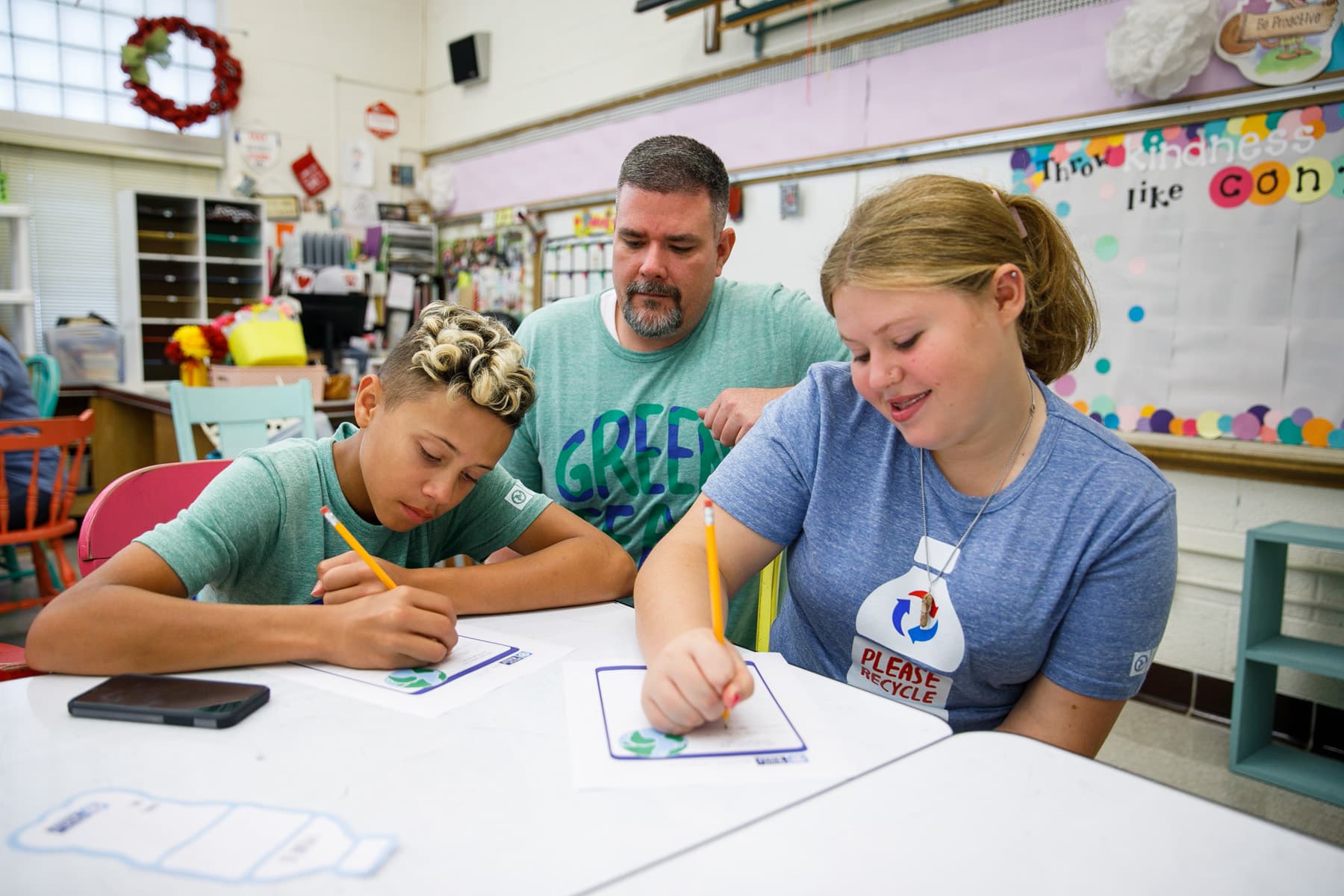25 Recycling, Reusing, and Upcycling Math Challenges
Counting, sorting, graphing, and more!

The more often kids hear the message about the importance of recycling, the more likely they are to make it a part of their daily lives as they grow up. Incorporating these concepts into lesson plans across the curriculum reinforces the good choices we want kids to make. That’s why we’ve put together this list of recycling math challenges and activities. There are plenty of ways to practice math skills while you recycle, reuse, and upcycle materials. Plus, many of them can be differentiated to use with kids of a variety of ages. There’s something here for everyone!
1. String a number chain

Snip cardboard tubes into shorter lengths (paint them bright colors first, if you like). Then number them 1 to 10 or more. Have kids string them onto a length of yarn in the correct order. Try this activity for skip counting too.
2. Reuse egg cartons for sorting and counting
Practice sorting small items by color or size into the sections of an egg carton. For older students, trim two sections off and turn an egg carton into a 10 frame. (Get lots of ideas for using 10 frames with your students here.)
3. Upcycle cardboard boxes into giant dice
Dice are classroom staples for math learning, and oversized versions are fun for whole-class activities. Create your own oversized dice by adding dots or numerals to the sides of a big square box. Then, find some of our favorite classroom dice games here.
4. Work on estimation with a bottle cap guessing game
Collect several hundred plastic bottle caps in a large container and ask students to use their estimation skills to determine how many bottle caps there are. Offer a prize to the student who’s the closest. You can also have students use clear cups to scoop up some caps and estimate the amount or spill them out to practice subitizing. Learn more here.
5. Use catalogs and ads to master money skills
Round up grocery ads and toy store catalogs, then give kids a budget and let them go “shopping”! You can even give kids play money to make the experience feel more real. Bonus: challenge them to figure out the sales tax too!
6. Upcycle materials into a calculator

Use toilet paper tubes or plastic cups with the bottoms cut off for this math idea. Attach the cups or tubes as shown to a piece of cardboard, then drop small items (like bottlecaps or pompoms) through and count them as you go! Visit The Best Ideas For Kids to learn more.
7. Make plastic bottle bowling pins
Plastic bottle bowling pins are perfect for recycled math activities! For a basic game, kids set up 10 pins and roll the ball. Then they subtract the number they knock down from 10. Expand the learning by having kids graph their results, figure out their average scores, or use rulers to measure how far the pins go flying. (For some extra spooky fun, give Mummy Bowling a try!)
8. Measure circumference and diameter with bottles and cans
Gather a variety of bottles and cans in different sizes, then equip students with measuring tapes so they can determine the circumference. (Yarn and rulers will work too.) Older students can work on figuring out the diameter or radius, and even check their results by cutting the container in half to measure it that way too.
9. Assemble self-checking math problem lids
Save flip-top lids from plastic bottles. Write a math equation on the top of each one, then flip it open and write the answer inside. Students figure out the solution, then open the lid to find out if they’re correct. This provides fine motor skill practice along with math learning.
10. Go on a scavenger hunt
Give students a pile of newspapers or magazines and some scissors. Then have them scour the pages to find numbers that fit requirements like, “Find a 4 in the tens place” or “Find an 8 in the thousands place.” You can make it a group project, or even have a competition to see who can find the right number first. Differentiate this recycling math activity by having younger students search for numbers or shapes.
11. Study graphs and charts about recycling
This recycling math lesson plan helps students understand the process of transforming plastic into new products. It includes a hands-on activity where kids make bar graphs or pie charts with recycling statistics. Expand on this concept for any other types of graphs or charts your students are studying.
12. Give plastic Easter eggs new life

Don’t toss your plastic eggs after the Easter Bunny is gone! Reuse them for all sorts of learning activities, including math. Write different equivalent fractions on each half of an egg, then challenge students to match them. Or, write a math problem on one and the answer on another. Find lots of plastic egg ideas here.
13. Count recyclables as you sort
Practice sorting recyclable items into the right bins, counting along as you go. Feeling energetic? Hold a trick shot contest or play recycling cornhole, making sure students count to keep score!
14. Write math recycling word problems
Give your word problems a recycling spin. Here’s an example: “Ms. Patel’s class is picking up litter on the playground. Olivia found 3 soda cans, 4 candy bar wrappers, and 8 flyers from the school’s bake sale. Julio found 4 plastic soda bottles, 1 old newspaper, and 2 fast-food drink cups. How many items did they find altogether? How many of these items can they recycle?”
15. Stack and count cans, yogurt containers, or coffee machine cups
Collect and clean soda cans or coffee machine cups, then use them for a variety of stacking activities. Have kids estimate how many cans they’ll need to stack to reach from the floor to the top of their desk, or even to the top of their heads, then see how close they were. Or, challenge teams to build the biggest pyramid of containers they can in one minute, then count their results. There are a lot of ways to stack and play!
16. Learn about volume
Find out how many teaspoons of water it takes to fill an empty soda bottle, or compare the volume of short fat containers compared with tall thin ones. You can even calculate the volume of your recycling bins!
17. Build a hundreds chart with bottle caps
You’ll need 100 plastic bottle caps for this recycling math idea. Number them 1 to 100, then lay them out in rows of ten to serve as a hands-on hundreds chart. Mix it up by making the even numbers one color and the odd numbers another, or making all the fives and tens a separate color—you get the idea. Discover more about hundreds charts here.
18. Craft upcycled flashcards

Customize your own flashcards by writing on plastic container lids, bottle caps, or even cardboard scraps cut into fun shapes. Try one of our favorites: flashcard pancakes! Cut out circles of cardboard and turn them into flashcards for any math fact you’re working to master. Then, lay them out and have kids flip them with a spatula to check their answers.
19. Make patterns with recyclables
Young students work to recognize patterns like ABAB or ABBA. Try making various patterns with your recycling items like bottles and cans before you toss them in the bin.
20. Add up your bottle returns
Some areas offer a few cents for each bottle you collect and recycle. Take a look at your own recyclables to see which ones have a bottle return reward, and add up your potential profits. If you live in an area with a bottle deposit refund, take advantage of it! Collect the funds and save up for a classroom reward like a pizza party.
21. Survey and calculate recycling statistics at your school
Use recycling math to do some statistical analysis. Survey fellow students or families to find out what their recycling habits are, then add up the numbers and analyze the data. Find out how to introduce even young students to statistics here.
22. Sort, tally, and graph your lunches
Invite students to organize, represent, and interpret their lunch into data! Before throwing their lunch remains away, have students sort it into categories (paper, plastic, aluminum, glass, compost, trash). Tally how many they have of each item. Then, as a class, create a graph of all of the materials that were found in their lunch. See more here.
23. Cut out cardboard shapes and create

As your students learn various shapes, cut them out of thin cardboard (like cereal boxes). Then, have kids create something amazing! When they’re done, count up the numbers of various shapes they used. See this and other geometric art explorations here.
24. Learn with counting cups
Small lidded containers like yogurt cups work best for this one. Cut a small opening in the top of the lid and write a number on the outside of the cup. (Try removing the printing with nail polish remover; then, you can write on the container with a dry erase marker. You can also just add sticky notes to the containers.) Once they’re ready to go, ask students to drop small items into the cup, counting as they go. This is a fun way to work on money skills too.
25. Upcycle packing material into 3-D shapes
Save those foam sheets and pieces of packing material, then carefully trim them into 3-D shapes like pyramids, cones, and cylinders. Now you’ve got shape blocks that didn’t cost you a penny!
Learn More

Recycle Rally
Recycle Rally is a free K-12 program that provides rewards and tools to help enhance recycling at your school!
Explore now
Additional Resources
Our comprehensive library of resources was designed to inspire the next generation of green leaders.
Explore now
